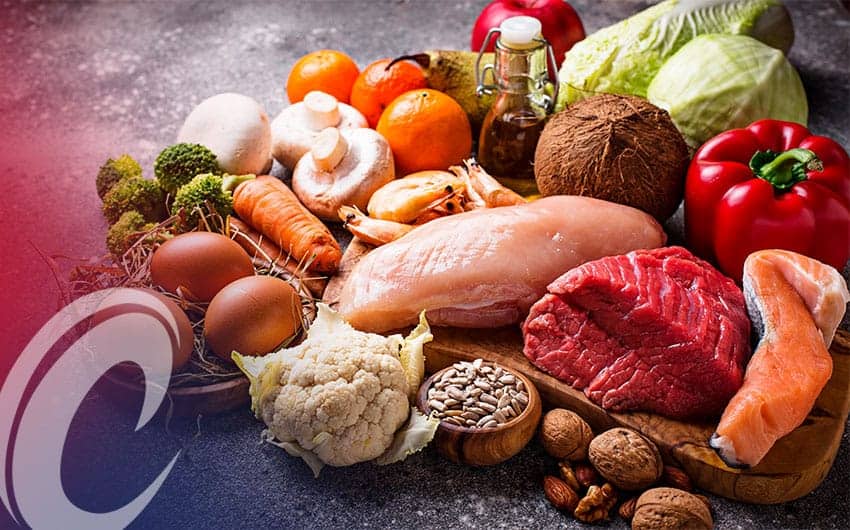Examining the Pros and Cons of the Paleo Diet
From the Experts at Precision Nutrition
Unless you’ve been living in an actual cave, you’ve probably heard all about the Paleo – or “caveman” – diet. Maybe you’ve even tried it. A little meat here, some fresh veggies there. Perhaps going grain- or processed-food-free. It’s a cool idea that captures the imagination. But is it healthy? And does it work?
“Paleo” defined
The Paleo, or primal, diet is based on two central ideas:
- We adapted to eat particular kinds of foods.
- To stay healthy, strong, and fit — and avoid the chronic diseases of modernity — we need to eat like our ancestors.
And thus, we arrive at a model of a Paleo diet that includes:
- animals (meat, fish, reptiles, insects, etc. — and usually, almost all parts of the animals, including organs, bone marrow, and cartilage)
- animal products (such as eggs or honey)
- roots/tubers, leaves, flowers and stems (in other words, vegetables)
- fruits
- nuts and seeds that can be eaten raw
Recently, many Paleo proponents have suggested that eaters start with the above, then slowly introduce grass-fed dairy (mostly yogurt and other cultured options), and small amounts of “properly prepared” legumes — meaning legumes that have been soaked overnight.
 The main idea of a primal diet — as you’ve probably gathered (no pun intended) — is that our ancient human genetic “blueprint” doesn’t match our current 21st century diet and lifestyle. As a result, our health and wellbeing suffer. Today, the average American subsists on foods that are packaged and commercially prepared. Rich in refined sugars and starches, highly processed fats, and sodium, these foods are designed to be so delicious that they run roughshod over the body’s normal fullness signals, and encourage overeating.
The main idea of a primal diet — as you’ve probably gathered (no pun intended) — is that our ancient human genetic “blueprint” doesn’t match our current 21st century diet and lifestyle. As a result, our health and wellbeing suffer. Today, the average American subsists on foods that are packaged and commercially prepared. Rich in refined sugars and starches, highly processed fats, and sodium, these foods are designed to be so delicious that they run roughshod over the body’s normal fullness signals, and encourage overeating.
What does the Paleo diet get right?
Despite the faulty evolutionary theory it’s based on, in the end, the Paleo diet likely gets more right than it gets wrong.
- Paleo-style eating emphasizes whole foods, lean proteins, vegetables, fruits, nuts, seeds, and other healthy fats, which is a massive improvement over the average Western diet.
- Paleo-style eating has been extremely effective for improving several chronic diseases. That alone is a huge plus.
- Paleo-style eating has made us more aware of how processed and crappy a lot of our 21st century food is.
However, we need more rigorous (and carefully matched) trials before we can reach any definitive conclusions.
What are the challenges?
Despite its obvious benefits over the typical Western diet, the Paleo diet has some flaws:
- The evidence for excluding dairy, legumes, and grains isn’t (yet) strong. So as a nutrition coach, I can’t say it’s a one-size-fits-all prescription. Certainly, some people should avoid dairy and gluten, and keep legume and grain consumption more modest. But most of us can improve the way we look, feel, and perform without completely eliminating these foods.
- The evolutionary arguments don’t hold up. The human species isn’t simply a collection of adaptations to life in the Paleolithic era. We are an ever-evolving accumulation of inherited characteristics (and microorganisms) that have been switched, reconstructed, lost, and reclaimed since the first prokaryotes came to life on Earth. This evolution has continued over the past 10,000 years — and won’t stop any time soon.
- In the broader sense, strictly following a list of “good” and “bad” or “allowed” and “not allowed” foods tends to be problematic for most people. Generally, this approach leads to anxiety and all-or-nothing thinking. Maybe it makes us feel more confident and (falsely) sure of ourselves in the short term. But it’s less effective over the long-term — because ultimately, it decreases our consistency.
This may explain why we are seeing the Paleo diet itself evolve.
For more information on Precision Nutrition or the topic above, please contact Mike Hannegan, PN1 at mike@competeperformance.com

